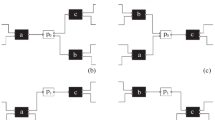Abstract
This paper3 newly defines a workflow reduction mechanism that formally and automatically reduces an original workflow process to a minimal set of activities, which is called minimal-workflowmodel in this paper. It also describes about the implications of the minimal-workflow model on workflow mining that is a newly emerging research issue for rediscovering and reengineering workflow models from workflow logs containing workflow enactment and audit information gathered being executed on workflow engine. In principle, the minimal-workflow model is reduced from the original workflow processby analyzing dependencies among its activities. Its main purpose is to minimize discrepancies between the modeled workflow process and the enacted workflow process as it is actually being executed. That is, we can get a complete set of activity firing sequences (all reachable-pathsfrom the start to the end activity on a workflow process) on buildtime. Besides, we can discover from workflow logsthat which path out of all reachable paths a workcase (instance of workflow process) has actually followed through on runtime. These are very important information gain acquiring the runtime statistical significance and knowledge for redesigning and reengineering the workflow process. The minimal-workflow model presented in this paper is used to be a decision tree induction technique for mining and discovering a reachable-path of workcase from workflow logs. In a consequence, workflow miningmethodologies and systems are rapidly growing and coping with a wide diversity of domains in terms of their applications and working environments. So, the literature needs various, advanced, and specialized workflow mining techniques and architectures that are used for finally feed-backing their analysis results to the redesign and reengineering phase of the existingworkflow and business
Preview
Unable to display preview. Download preview PDF.
Similar content being viewed by others
Author information
Authors and Affiliations
Editor information
Rights and permissions
About this chapter
Cite this chapter
Kim, KH., A. Ellis, C. Workflow Reduction for Reachable-path Rediscovery in Workflow Mining. In: Young Lin, T., Ohsuga, S., Liau, CJ., Hu, X. (eds) Foundations and Novel Approaches in Data Mining. Studies in Computational Intelligence, vol 9. Springer, Berlin, Heidelberg. https://doi.org/10.1007/11539827_17
Download citation
DOI: https://doi.org/10.1007/11539827_17
Published:
Publisher Name: Springer, Berlin, Heidelberg
Print ISBN: 978-3-540-28315-7
Online ISBN: 978-3-540-31229-1
eBook Packages: EngineeringEngineering (R0)




